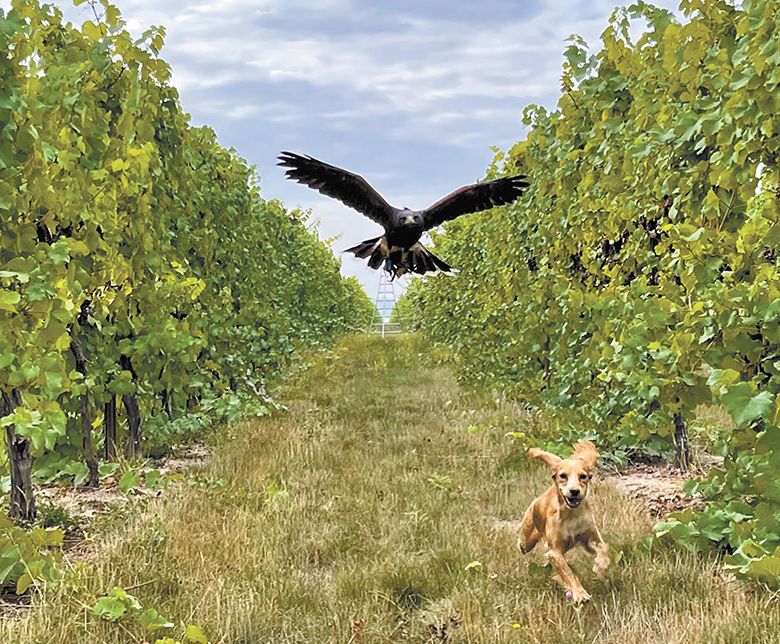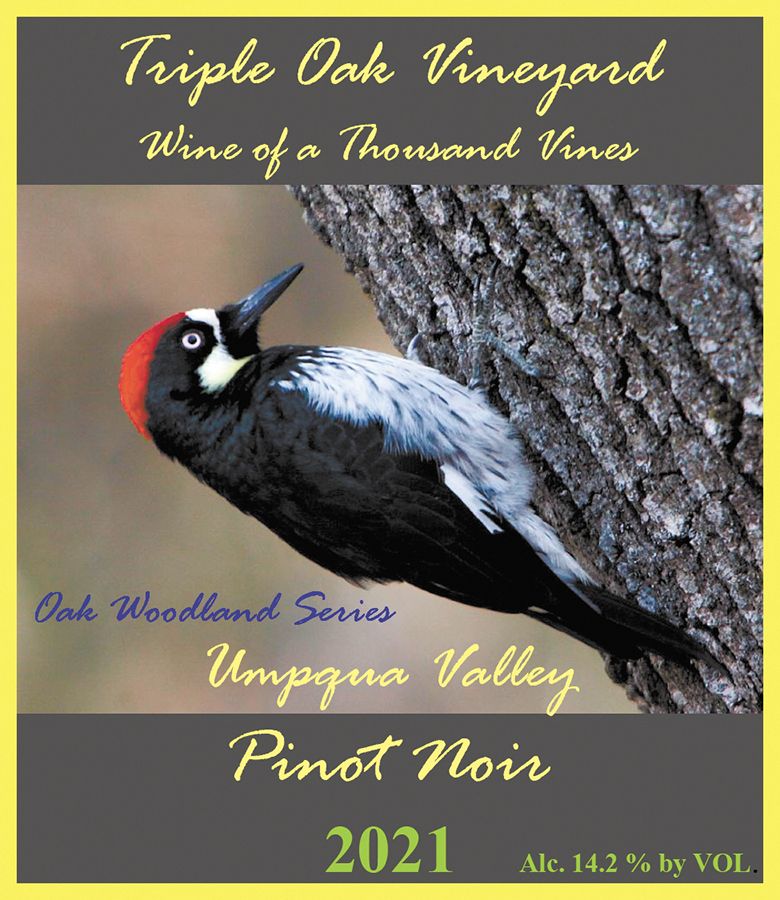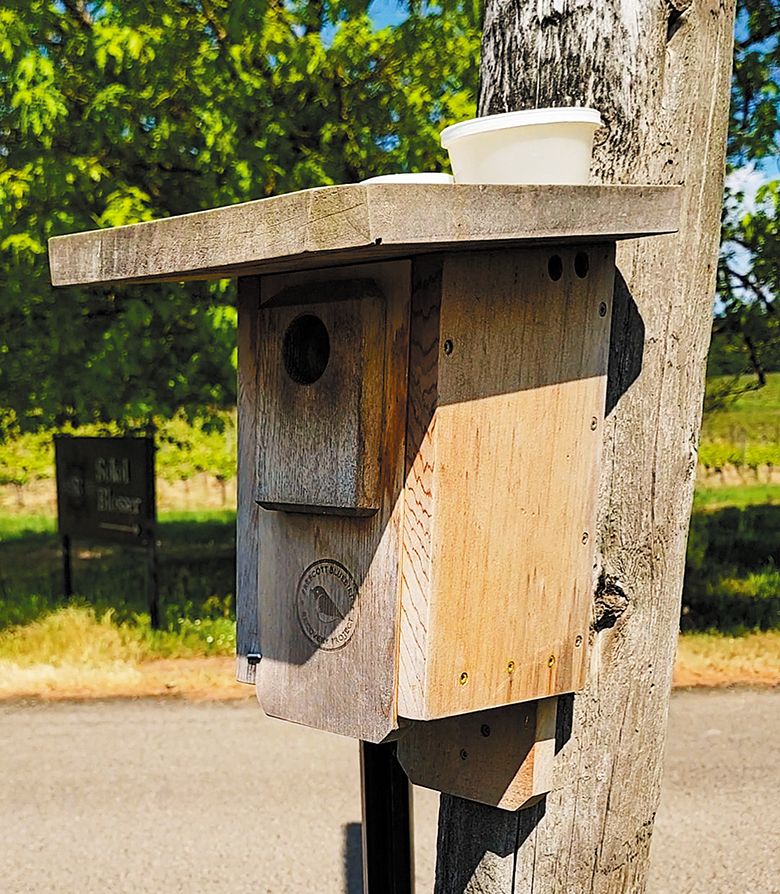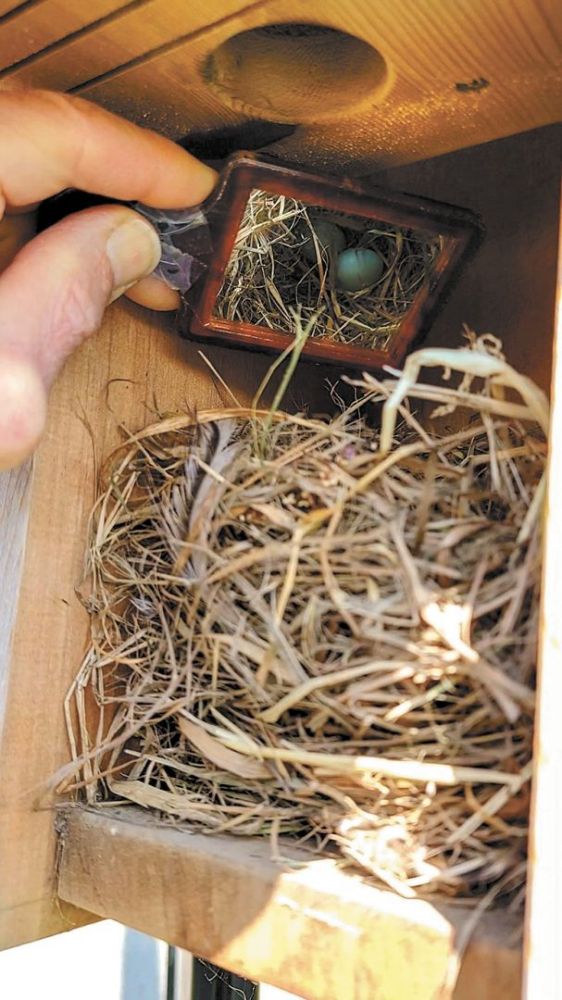Wings and Wine
Discover native and migrating fowl in wine country




By Greg Norton
Approximately one-third of American adults– over 96 million people– engaged in some form of birdwatching in 2022. That surprising figure from the U.S. Fish and Wildlife Service reveals a dramatic increase in ornithological interest since the pandemic.
If you don’t consider yourself part of the boom, maybe you should. Recent studies reported by The Washington Post linked interaction with nature– and the sound of birdsong specifically– with improved mental health. Reduced levels of stress and anxiety, and even improved cognition were found among study participants.
Birds are everywhere, inviting us to deepen our understanding of nature and its benefits. This is especially true in Oregon’s wine country, where they not only live alongside the vines but also assume roles as avian vineyard workers.
AVIAN NEIGHBORS
Partners in life as well as in business, Malia Myers and Melaney Schmidt recently moved their sparkling wine-focused winery, Landmass Wines, to the Columbia Gorge. By relocating to Cascade Locks, they reduced costs and made sourcing fruit from both Oregon and eastern Washington vineyards easier. Proximity to the Columbia River also supplies a front-row seat to view area bird activity. Nesting ospreys and circling turkey vultures are fair-weather friends while winter and spring bring sightings of bald eagles. Heron and other waterfowl live there year-round. Eager to share the experience, the winery welcomes groups of six or more for wine tastings by appointment.
West of Salem, near Dallas, lays the nearly 2500-acre Baskett Slough National Wildlife Refuge, a vital habitat for many bird species. Named for the original settler and landowner, George J. Baskett, the slough includes trails, observation decks and access roads, allowing a visit any time of year. The preserve, established in 1965, becomes a wintering home for dusky Canada geese. Now, bald eagles, kestrels, owls, pintails and streaked horned larks flourish there.
Waterfowl proliferate in the winter while spring welcomes other migratory birds. “The big migration is late April [and] early May when the warblers are coming through,” notes Frank Kolwicz, a local photographer who has spent countless hours capturing images of the preserve’s avian visitors.
As the wetlands give way to farmlands northwest of Baskett Slough, the vineyards of the Van Duzer Corridor AVA become visible. Andante Vineyard’s inviting tasting room and production facility rests on a knoll between the wildlife refuge and a preserved oak savannah bordering the surrounding vines. Their portfolio of small-production wines reflects a serious commitment to whites, including Sauvignon Blanc, Aligoté and Chardonnay. They also craft Pinot Noir and other red varieties. Enticing food pairings, prepared by executive chef Caleb Warner, make this a deliciousdestination for hungry wine lovers visiting Baskett Slough.
Egrets, frequently seen on the property’s pond and a walking path, invite guests to explore the site. Brandon Correa, wine to vine principal, recalls hearing the hoots of Great Horned Owls while walking the path on his first day on the job. “You just feel it in your bones,” he recalled.
Farther south, in the Umpqua Valley, Ford’s Pond offers municipal park-like amenities along with hiking trails, wetlands and oak savanna. Over 200 species of birds have been sighted here, including migratory populations. The 95-acre pond was created in the 1950s for the storage needs of a logging company. Since then, the city of Sutherlin purchased the 202-acre site and, in cooperation with the enthusiastic advocacy of the nonprofit Friends of Ford’s Pond, has added accessible features, including paved parking and a playground.
Nearby, amid the antique shops of quaint downtown Historic Oakland, is the Triple Oak Wine Vault tasting room, housed in an old bank building. Owner Betty Tamm has two acres of grapevines a few miles away. They grow alongside a mixed oak woodland. Triple Oak’s award-winning wines include red and white blends, Gewürztraminer, Pinot Gris, Pinot Noir and Tempranillo.
“I’ve always been interested in birds residing within oak woodland,” Tamm said. “You get a lot of birds that thrive in that habitat.” She shares her interest by depicting birds on her wine labels and delights in the conservation efforts underway at Ford’s Pond. A visit to the historic town could be followed by a picnic at the pond. “It’s a wonderful outing,” she said. And, by booking her adjacent Airbnb, “people can make a weekend of it.”
WORKING BIRDS
Some Oregon vineyards rely on birds to help control insect and rodent pests, reducing the need for chemicals while contributing to a sustainable farming environment.
Newberg’s Raptor Ridge Winery, in the Laurelwood District AVA, frequently hosts local birdwatchers as they sample wine on the property’s aptly named “Flight Deck.” Red-tailed hawks, bald eagles and owls frequently hunt between the vines, according to their director of marketing and membership, Tanya Zumach. “We are a sustainability-focused winery and, as such, encourage our birds of prey neighbors to live here and provide a natural balance to the environment,” she said.
Master falconer Alina Blankenship is committed to education about birds of prey. Her nonprofit organizations PERCH and Wings Over Wine partner with wineries, schools and community groups. “When you’re a hair’s width away from my great horned owl and her giant yellow eyes, it’s transformative for a lot of people,” she said.
In addition to consulting with vineyards like Raptor Ridge on how best to attract rodent-hunting birds, she also runs Sky Guardian, with trained falcons to discourage smaller birds from eating grapes at harvest time. “When I have 10,000 starlings over a grape crop, I put up what I call my ‘border collie,’” she explained. “And she follows them up, pushes them down the row, scaring them right off the property.” (Blankenship was profiled in our October 2021 issue.)
Sokol Blosser Winery is one Oregon vineyard employing birds to control insect pests while also sustaining endangered species. In partnership with the Prescott Bluebird Recovery Project, or PBRP, the winery shelters the Western Bluebird, listed as a “sensitive species” by the Oregon Department of Fish and Wildlife. For over 20 years, bluebird houses on the property have provided nesting shelter for the birds. They then return the favor by controlling insects, thereby reducing the need for insecticides. The numbers of nests, eggs, chicks and fledglings are tracked annually and reported to PBRP.
“They’re really gorgeous little birds. And one of the reasons why it’s important to target them for nesting is that they’re pretty shy,” according to Susan Sokol Blosser, winery founder and garden advisor. “They don’t eat the grapes, they eat the insects, which is really lovely because we are a certified organic vineyard.”
The winery’s longstanding dedication is celebrated each June (the bluebird’s nesting month) with its Bluebird Rosé, a sparkling wine made using the Traditional Method. A portion of the month’s tasting room sales of the wine are donated to PBRP. The project enjoys similar partnerships with other vineyards in the upper Willamette Valley.
LOOKING UP
As an agricultural product, wine connects us to nature with stories of vineyard lifecycles, weather and geology. The activity of birds intertwines with cultivated crops and reveals the web of life that encompasses all of us. These partnerships encourage us to better care for our shared home.
On your next adventure into Oregon’s wine country, look up. You may spot an avian neighbor– a soaring bald eagle above a riverside highway, the flash of a bluebird among the vines, or a bird of prey on the hunt.
Plan your visit:
Landmass Wines, landmasswines.com
Baskett Slough National Wildlife Refuge, 10995 Highway 22, Dallas, fws.gov/refuge/baskett-slough
Andante Vineyard, 3855 Morris Rd., Dallas, andantevineyard.com
Ford’s Pond, 382 Church Rd., Sutherlin (location for GPS), fordspond.org
Triple Oak Wine Vault, 137 N.W. Locust St., Oakland, tripleoakwinevault.com
Raptor Ridge Winery, 18700 S.W. Hillsboro Hwy., Newberg, raptorridgewinery.com
Sokol Blosser Winery, 5000 N.E. Sokol Blosser Ln., Dayton, sokolblosser.com
Learn more:
Download Merlin, a free smartphone app, merlin.allaboutbirds.org
Answer three simple questions about a bird you are trying to identify and Merlin will list possible matches. It can also “listen” to the birds around you or use your photo to suggest real-time identifications.
Wings Over Wine, wingsoverwine.com
PERCH Wildlife Education, theperch.org
Sky Guardian, skyguardianfalconry.com
Prescott Bluebird Recovery Project, prescottbluebird.com
Greg Norton is a freelance writer with a broad background in nonprofit communications and the arts. He studied journalistic writing through the UCLA Extension and has traveled to wine regions around the world. Greg is a Certified Specialist of Wine and received the Level II award from the Wine and Spirits Education Trust. When not writing about wine, he can be found pouring it in the tasting room at Campbell Lane Winery near West Linn. Read more by Greg at www.onthevine.blog.








